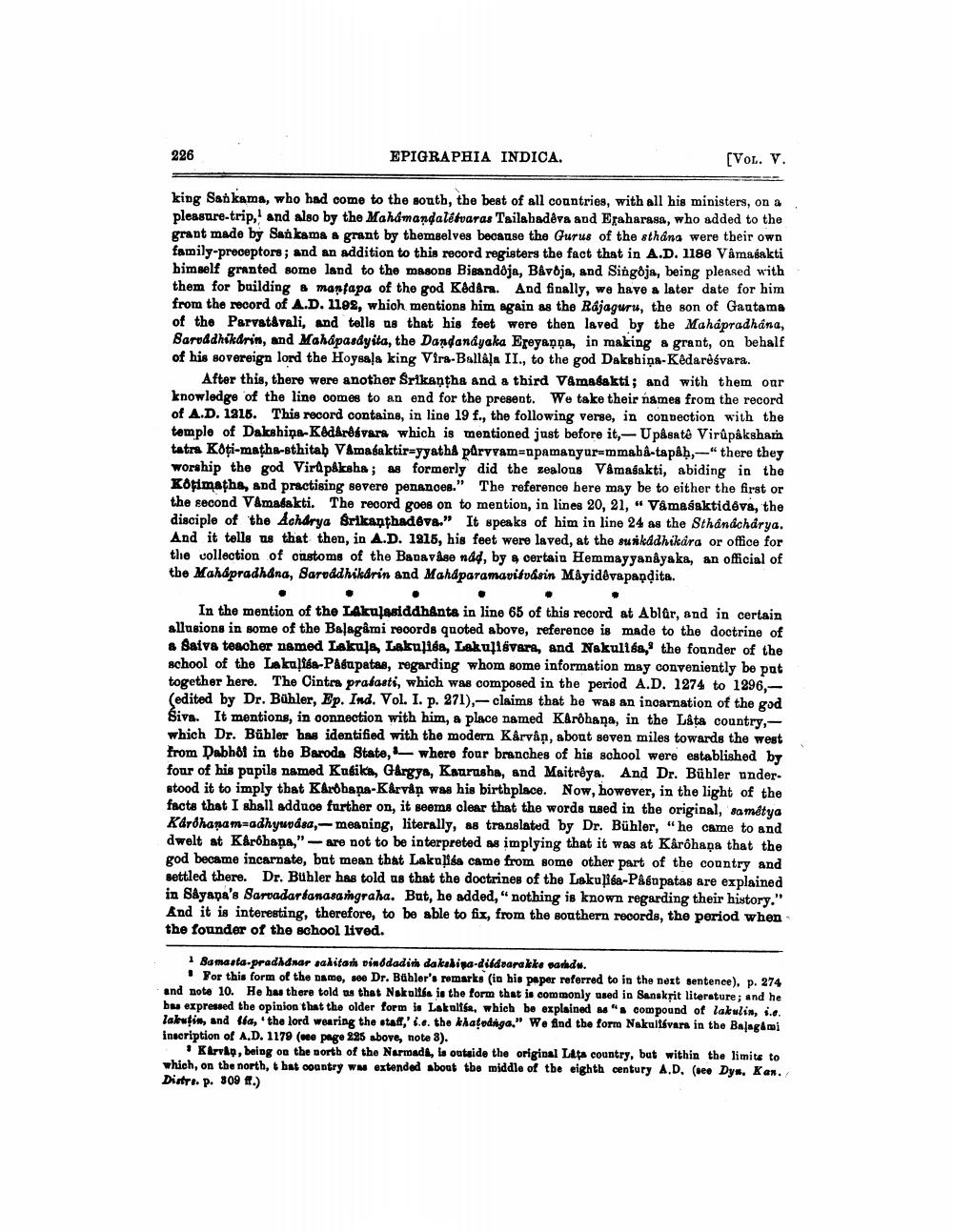________________
226
EPIGRAPHIA INDICA.
(VOL. V.
king Sankama, who had come to the south, the best of all countries, with all his ministers, on a pleasure-trip, and also by the Mahamandalesvaras Tailahadeva and Eraharasa, who added to the grant made by San kama a grant by themselves because the Gurus of the sthana were their own family-preceptors; and an addition to this record registers the fact that in A.D. 1186 Vâmasakti bimself granted some land to the masong Bisandôja, B&voja, and Singoja, being pleased with them for building & mantapa of the god Kadan. And finally, we have a later date for him from the record of A.D. 1192, which mentions him again as the Rajaguru, the son of Gautama of the Parvatávali, and tells us that his feet were then laved by the Mahápradhana, Baroddhikarin, and Mahápasdyita, the Dandanayaka Eroyanna, in making a grant, on behalf of his sovereign lord the Hoysala king Vira-Ballkla II., to the god Dakshiņa-Kedarêśvara.
After this, there were another Srikantha and a third Vamasakti; and with them our knowledge of the line oomes to an end for the present. We take their names from the record of A.D. 1215. This record contains, in line 19 f., the following verse, in connection with the temple of Dakshina-Kádárdsvars which is mentioned just before it,- Upåsate Virûpåksham tatra Koti-matha-sthitaḥ Vámasaktir-yyathe pärveam= pamanyur=mmabê-tapaḥ,-" there they worship the god Virupaksha; as formerly did the zealous V&masakti, abiding in the Korimatha, and practising severe penanoes." The reference bere may be to either the first or the second Vamalakti. The record goes on to mention, in lines 20, 21, " Våmasaktidéve, the disciple of the Achdrya srikanthad&ve." It speaks of him in line 24 as the Sthânácharya. And it tells us that then, in A.D. 1815, his feet were laved, at the suskadhikara or office for the collection of customs of the Banavåse nad, by certain Hemmayyanayaka, an official of the Mahápradhana, Saruddhikarin and Mahaparamavitvasin Máyidêvapaņdita.
In the mention of the Lakulasiddhanta in line 65 of this record at Ablar, and in certain allusions in some of the Balagåmi records quoted above, reference is made to the doctrine of
Saiva teacher named Lakula, Lakulisa, Lakuligvara, and Nakulisa, the founder of the school of the Lakaisa-Påsapatas, regarding whom some information may conveniently be pat together here. The Cintra prafasts, which was composed in the period A.D. 1274 to 1296,(edited by Dr. Bohler, Ep. Ind. Vol. I. p. 271),-claims that he was an incarnation of the god Siva. It mentions, in connection with him, a place named Karóhana, in the Låta country, which Dr. Bübler has identified with the modern Kårvån, about seven miles towards the west from Dabbal in tbe Baroda State, where four branches of his school were established by four of his papils named Kusika, Gárgya, Kaurasha, and Maitrêya. And Dr. Bübler ander. stood it to imply that Karóhana-Kårvåņ was his birthplace. Now, however, in the light of the facts that I shall adduce further on, it seems clear that the words tied in the original, samétya Karohanam-adhyupása, - meaning, literally, as translated by Dr. Bühler, "he came to and dwelt at Kåróbapa," - are not to be interpreted as implying that it was at Kårôhana that the god became incarnate, but mean that Lakulisa came from some other part of the country and settled there. Dr. Buhler has told us that the doctrines of the Lakulisa-Pagpatas are explained in Sayapa's Sarvadartanasangraha. But, he added, "nothing is known regarding their history." And it is interesting, therefore, to be able to fix, from the southern records, the period when the founder of the school lived.
Bamasta pradidnar sakitan pinddadiri dakalipa-dildvarakke aardu.
For this form of the name, so Dr. Bühler's remarks in his paper referred to in the next sentence), p. 274 and note 10. He has there told us that Nakulita is the form that is commonly used in Sanskpit literature, and he bus expressed the opinion that the older form in Lakulisa, which be explained " compound of lalulin, 1.. lalutin, and fla, 'the lord wearing the staff,' .... the khatodaga." We find the form Nakull vara in the Balagåmi inscription of A.D. 1179 (see page 225 above, note 3).
1 Karvko, being on the north of the Narmada, is outside the original Lata country, but within the limits to which, on the north, that country ww extended about the middle of the eighth century A.D. (nee Dys, Kan. Distt. P. 309 f.)




